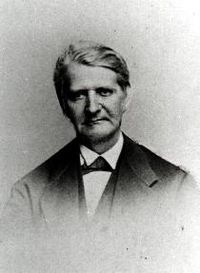Arnold Förster
Arnold Foerster ( notation according to grave, in some sources also: forester; born January 20, 1810 in Aachen, † August 13, 1884 ) was a German botanist and entomologist. Its official botanical author abbreviation is " Foerst. ".
Life and work
The son of the farmer Caspar Giles Arnold Foerster (1779-1821) and Catherine Angelika Duyckers (1786-1846) was still a schoolboy strong interest in insects and therefore visited regularly living in the neighboring Stolberg entomologist Johann Wilhelm Meigen, which on the development Foerster, the age of eleven, lost his father, received large influence. Nevertheless Foerster began after graduating from high school, first to study medicine at the University of Bonn, but decided once for the field of the natural sciences in August Goldfuß. Between these two, developed quite quickly a friendly relationship and Goldfuß made to dwell the right penniless students Foerster not only in itself, but used him as a tutor for his children and as assistants in his institute. Other important Foerster for high school teachers in this period were the botanist Christian Gottfried Daniel Nees von Esenbeck and Ludolph Christian Treviranus and mineralogist Johann Jacob Noeggerath.
After completing his studies Foerster found in 1836 a position at the in a year earlier established " Higher public school ", which later became the Rhine-Meuse -Gymnasium Aachen, where he found a competent professional colleagues with the Johann Heinrich Kaltenbach one years set for him. Foerster knew at this school his service until shortly before his death and was here in 1850 promoted to senior teacher and received the title of professor in 1855.
During this time, he deepened his research in the field of entomology and botany, and made three more trips to this end, to Switzerland, where he among other things, at the Hymenopterologen Emil Frey- Gessner (1826-1917) found shelter. Foerster summarized his studies on the various groups of insects in numerous monographs, which, however, he mainly devoted himself to Hymenoptera. In particular Foerster contributed significantly to the fact that many new genera and species have been described of the families of Gall and parasitic wasps and their kinship circle of Chalcidoidean, Proctotrupidaen and Braconidaen. His interest was mainly the domestic species, of which he published in 1847 by him "Overview of the beetle fauna of the Rhine Province " listed in 2747 alone, the Aachen Lousberg Foerster recorded 672 species of butterflies and moths on the day.
In addition to his entomological research Foerster operated also in the field of botany and published a work on the genus Rubus and was Zuarbeiter for the botanist Philip Wirtgen and its publication "Flora of the Prussian Rhineland ." In addition, he was in 1843 in Aachen, one of the founders of the " Natural History Association for the Prussian Rhineland ," in 1849 with the " Botanical Club on Central and Lower Rhine " to the Natural History Association of the Rhineland and Westphalia merged and for which he is the zoological section took over.
Despite its wide-ranging obligations Foerster found time to engage in politically and entered in 1845 of " Constantia Society " at, a Catholic choice and Citizens' Association, which he led as president from 1873 to 1876. He also was a member of the Centre Party in a few years the city council.
For his contributions to entomology Arnold Foerster in 1853 from the University of Bonn Dr. phil. h c. appointed. In addition, a street was named after him near the Aachener Lousberg.
After his death Foerster were acquired extensive collections of recognized individuals and by various scientific institutions, including the Natural History Museum of Vienna and the Zoological State Collection Munich.
Arnold Foerster was married to Maria Barbara, born Zimmermann (1810-1889), with whom he had three sons and daughters. He found his final resting place at the Aachen East Cemetery.
Memberships (Selection)
Foerster quickly gained an international reputation, and he was recording in many entomological and scientific societies, including:
- Stettin Entomological Club, 1842
- Nature Historical Society for the Prussian Rhineland, 1843
- Imperial Leopoldine Carolinian Academy of Sciences, 1853
- Linnéenne Société de Lyon, 1854
- Nederlandsche Vereeniging Entomogiche, 1855
- Zoological and Botanical Society of Vienna, 1855
- Entomological Society in Berlin, 1857
- Societas Caes. n c. Mosquensis, 1858
- Swiss Entomological Society, 1881
In addition, in 1863, appointed the Free German Hochstift to Frankfurt am Main Foerster honorary member and the " master of Entomology ".
Works (selection)
- Contributions to the monograph of Pteromalinen family. Nees, M. Urlichs 1840 ( digitized )
- Hymenopterologische studies, Ter Meer 1850 - 1856 ( biodiversity heritage library) Formicariae, In: Volume 1 of Hymenopterologische studies, Ter Meer 1850
- Chalcidiae and Proctotrupii, In: Volume 2 of Hymenopterologische studies, Ter Meer 1856 ( digitized )
Literature and sources
- Ingeborg shield, Elisabeth Janssen: The Aachen East Cemetery. Mayersche bookstore, Aachen, 1991, pp. 474-476, ISBN 3-87519-116-1.








